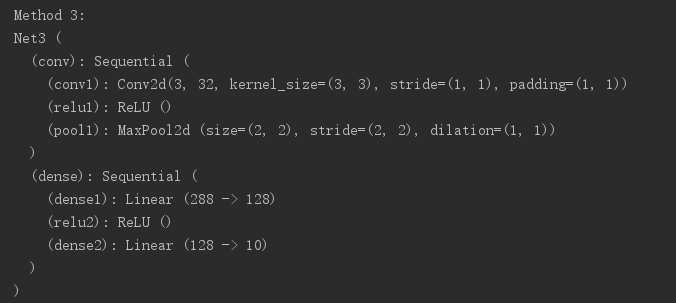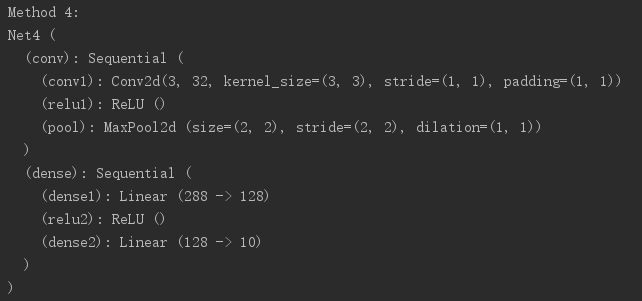利用pytorch来构建网络模型有很多种方法,以下简单列出其中的四种。
假设构建一个网络模型如下:
卷积层--》Relu层--》池化层--》全连接层--》Relu层--》全连接层
首先导入几种方法用到的包:
import torch import torch.nn.functional as F from collections import OrderedDict
第一种方法
# Method 1 ----------------------------------------- class Net1(torch.nn.Module): def __init__(self): super(Net1, self).__init__() self.conv1 = torch.nn.Conv2d(3, 32, 3, 1, 1) self.dense1 = torch.nn.Linear(32 * 3 * 3, 128) self.dense2 = torch.nn.Linear(128, 10) def forward(self, x): x = F.max_pool2d(F.relu(self.conv(x)), 2) x = x.view(x.size(0), -1) x = F.relu(self.dense1(x)) x = self.dense2(x) return x print("Method 1:") model1 = Net1() print(model1)

这种方法比较常用,早期的教程通常就是使用这种方法。
第二种方法
# Method 2 ------------------------------------------ class Net2(torch.nn.Module): def __init__(self): super(Net2, self).__init__() self.conv = torch.nn.Sequential( torch.nn.Conv2d(3, 32, 3, 1, 1), torch.nn.ReLU(), torch.nn.MaxPool2d(2)) self.dense = torch.nn.Sequential( torch.nn.Linear(32 * 3 * 3, 128), torch.nn.ReLU(), torch.nn.Linear(128, 10) ) def forward(self, x): conv_out = self.conv1(x) res = conv_out.view(conv_out.size(0), -1) out = self.dense(res) return out print("Method 2:") model2 = Net2() print(model2)

这种方法利用torch.nn.Sequential()容器进行快速搭建,模型的各层被顺序添加到容器中。缺点是每层的编号是默认的阿拉伯数字,不易区分。
第三种方法:
# Method 3 ------------------------------- class Net3(torch.nn.Module): def __init__(self): super(Net3, self).__init__() self.conv=torch.nn.Sequential() self.conv.add_module("conv1",torch.nn.Conv2d(3, 32, 3, 1, 1)) self.conv.add_module("relu1",torch.nn.ReLU()) self.conv.add_module("pool1",torch.nn.MaxPool2d(2)) self.dense = torch.nn.Sequential() self.dense.add_module("dense1",torch.nn.Linear(32 * 3 * 3, 128)) self.dense.add_module("relu2",torch.nn.ReLU()) self.dense.add_module("dense2",torch.nn.Linear(128, 10)) def forward(self, x): conv_out = self.conv1(x) res = conv_out.view(conv_out.size(0), -1) out = self.dense(res) return out print("Method 3:") model3 = Net3() print(model3)

这种方法是对第二种方法的改进:通过add_module()添加每一层,并且为每一层增加了一个单独的名字。
第四种方法:
# Method 4 ------------------------------------------ class Net4(torch.nn.Module): def __init__(self): super(Net4, self).__init__() self.conv = torch.nn.Sequential( OrderedDict( [ ("conv1", torch.nn.Conv2d(3, 32, 3, 1, 1)), ("relu1", torch.nn.ReLU()), ("pool", torch.nn.MaxPool2d(2)) ] )) self.dense = torch.nn.Sequential( OrderedDict([ ("dense1", torch.nn.Linear(32 * 3 * 3, 128)), ("relu2", torch.nn.ReLU()), ("dense2", torch.nn.Linear(128, 10)) ]) ) def forward(self, x): conv_out = self.conv1(x) res = conv_out.view(conv_out.size(0), -1) out = self.dense(res) return out print("Method 4:") model4 = Net4() print(model4)

是第三种方法的另外一种写法,通过字典的形式添加每一层,并且设置单独的层名称。
完整代码:

import torch import torch.nn.functional as F from collections import OrderedDict # Method 1 ----------------------------------------- class Net1(torch.nn.Module): def __init__(self): super(Net1, self).__init__() self.conv1 = torch.nn.Conv2d(3, 32, 3, 1, 1) self.dense1 = torch.nn.Linear(32 * 3 * 3, 128) self.dense2 = torch.nn.Linear(128, 10) def forward(self, x): x = F.max_pool2d(F.relu(self.conv(x)), 2) x = x.view(x.size(0), -1) x = F.relu(self.dense1(x)) x = self.dense2() return x print("Method 1:") model1 = Net1() print(model1) # Method 2 ------------------------------------------ class Net2(torch.nn.Module): def __init__(self): super(Net2, self).__init__() self.conv = torch.nn.Sequential( torch.nn.Conv2d(3, 32, 3, 1, 1), torch.nn.ReLU(), torch.nn.MaxPool2d(2)) self.dense = torch.nn.Sequential( torch.nn.Linear(32 * 3 * 3, 128), torch.nn.ReLU(), torch.nn.Linear(128, 10) ) def forward(self, x): conv_out = self.conv1(x) res = conv_out.view(conv_out.size(0), -1) out = self.dense(res) return out print("Method 2:") model2 = Net2() print(model2) # Method 3 ------------------------------- class Net3(torch.nn.Module): def __init__(self): super(Net3, self).__init__() self.conv=torch.nn.Sequential() self.conv.add_module("conv1",torch.nn.Conv2d(3, 32, 3, 1, 1)) self.conv.add_module("relu1",torch.nn.ReLU()) self.conv.add_module("pool1",torch.nn.MaxPool2d(2)) self.dense = torch.nn.Sequential() self.dense.add_module("dense1",torch.nn.Linear(32 * 3 * 3, 128)) self.dense.add_module("relu2",torch.nn.ReLU()) self.dense.add_module("dense2",torch.nn.Linear(128, 10)) def forward(self, x): conv_out = self.conv1(x) res = conv_out.view(conv_out.size(0), -1) out = self.dense(res) return out print("Method 3:") model3 = Net3() print(model3) # Method 4 ------------------------------------------ class Net4(torch.nn.Module): def __init__(self): super(Net4, self).__init__() self.conv = torch.nn.Sequential( OrderedDict( [ ("conv1", torch.nn.Conv2d(3, 32, 3, 1, 1)), ("relu1", torch.nn.ReLU()), ("pool", torch.nn.MaxPool2d(2)) ] )) self.dense = torch.nn.Sequential( OrderedDict([ ("dense1", torch.nn.Linear(32 * 3 * 3, 128)), ("relu2", torch.nn.ReLU()), ("dense2", torch.nn.Linear(128, 10)) ]) ) def forward(self, x): conv_out = self.conv1(x) res = conv_out.view(conv_out.size(0), -1) out = self.dense(res) return out print("Method 4:") model4 = Net4() print(model4)
